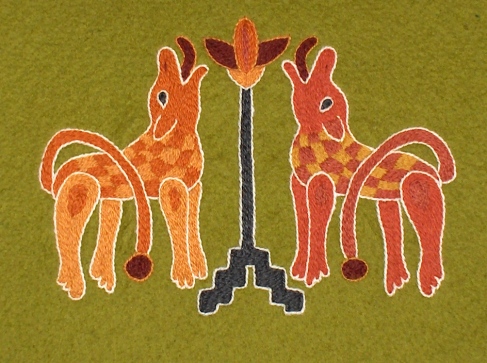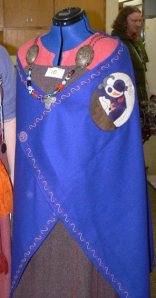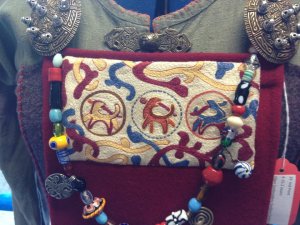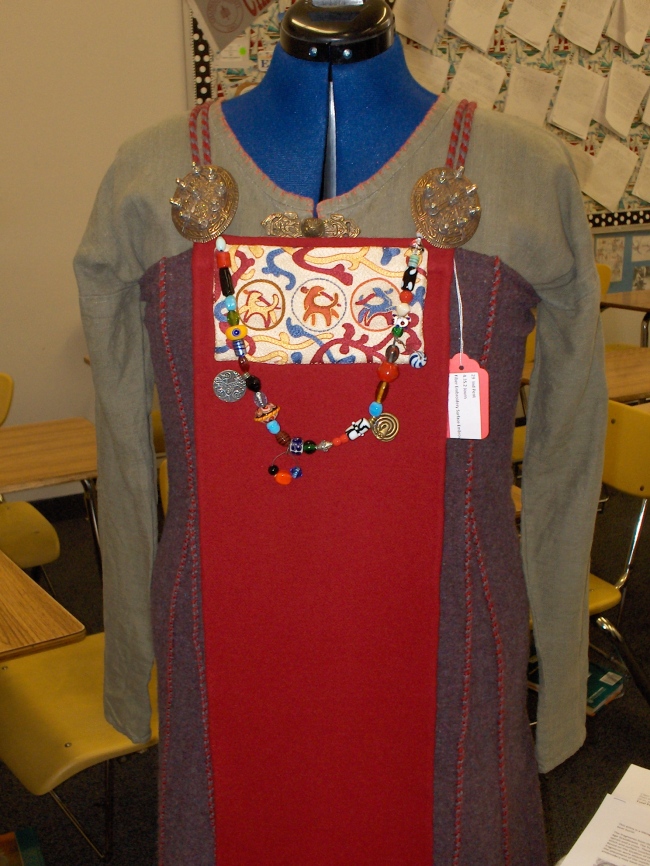This embroidered Viking Age gown (serk) was made for Queen Cassandra of Caid for her stepping-down coronation. The cut of the serk is based on 10th century finds from Hedeby, Denmark.
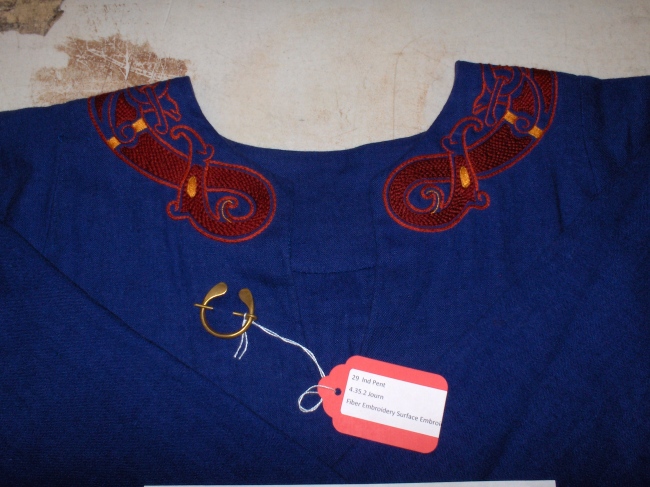



There are very few examples of Viking Age embroidered motifs; two of the best are from the excavations at Oseberg and Mammen. The fragments from Oseberg are dated to the mid 9th century and include several examples of silk embroidery which were worked using stem stitch, satin stitch, surface couching and split stitch (Christensen 399). The embroidered cloak from Mammen is dated to the late 10th century and was worked in wool using stem stitch (Priest-Dorman 1997). Neither of these examples of period embroidery use stitches other than those listed.
The Dress:
Several fragments from Hedeby provide evidence for a close fitting garment with side gores and inset sleeves. Hägg believes that these fragments came from men’s tunics (Hägg 43 and 50), however since they were found without the context of a grave, it is possible that they could be women’s garments. As in Glæsel (page 64), I feel that these fragments point to a garment constructed similarly to several medieval gowns from Herjolfsnæs, Greenland. The various Herjolfsnaes gowns were constructed with gores at the center front and back, plus multiple side panels (between four and eight) to add fullness (Ostergaard 127 – 129). The Hedeby fragment has only two side panels so it would be much narrower in the skirt than the gowns from Herjolfsnæs.
The fabric used for this garment is blue linen. Blue dyed linen was used for clothing during the Viking Age, as evidenced by a smokkr fragment of blue dyed linen decorated with red string from Birka grave 563 (Thunem). Based on the Regia dye equivalency, the color used is obtainable using woad.
I draped the pattern based on the fragments from Hedeby, resulting in a two-panel gown with inset sleeves and side gores that flare from 2” just under the arm to 10”at the hem. I decided not to include the gores at center front or back as I wanted a dress with simple lines that would lay smoothly under the smokkr, or apron-dress. I drafted a standard inset sleeve based on the recipient’s measurements, with the seam under the arm. The dress has a slight train based on Viking Age depictions of women, including the Oseberg tapestry and various ‘Valkyrie’ figurines.
The Embroidery:
The motifs used for the cuff embroidery are based on a 10th century cup from at Jelling, Denmark (Roesdahl 179), and the neckline embroidery is based on an 11th century silver bowl from Gotland, Sweden (Davis 34). I chose to use designs from Viking Age metal artifacts because there are so few extant examples of Viking Age embroidery.
I chose the materials and techniques based on the silk embroideries from Oseberg, which were worked in multicolored silk using stem stitch, satin stitch, split stitch and surface couching (Christensen 399).
The embroidery was done with Soie d’Alger silk embroidery thread; the colors were chosen to coordinate with the selected fabrics. Based on the Regia dye equivalency, the colors used would be obtainable using Viking Age dyes, including woad, madder, weld, walnut shell, and kermes. Both the neckline and cuff embroideries were done using stem stich, satin stitch, split stitch and surface couching.
The neckline embroidery was worked directly on the garment (as in the Mammen find), while the silk cuffs were embroidered separately and then attached to the serk. The cuffs were backed with linen to provide a secure base for the embroidery.
References
Christensen, Arne Emil. Osebergfunnet Bind IV Tekstilene. Forfatterne, 2006.
Davis, Courtney. Celtic and Old Norse Designs. Dover Publications Inc, 2000.
“Dye Equivalent Colours.“ Regia Anglorum http://www.regia.org/members/dyes.htm
Glæsel, Nille. Viking Clothing. Alf Jacobsens Boktrykkeri, 2010.
Hägg, Inga. “Die Textilfunde aus dem Hafen von Haithabu.” Berichte über die AUSGRABUNGEN IN HAITHABU, 1984. Translated in part using Google Translate http://translate.google.com
Ostergaard, Else. Woven into the Earth: Textile finds in Norse Greenland. Aarhus University Press, 2004.
Priest-Dorman, Carolyn. “Viking Embroidery Stitches and Motifs,” 1997 http://www.cs.vasser.edu/~capriest/vikembroid.html.
Roesdahl Else and David M Wilson, ed. From Viking to Crusader. Rizzoli International Publications; New York, NY. 1992.
Thunem, Hilde. ”Viking Women: Aprondress.” 2011. http://urd.priv.no/viking/smokkr.html
 The embroidery is based on the ‘tree of life’ design from the Mammen cloak. The embroidery is all done in stem stitch, which is consistent with the original piece. An interesting tid-bit about the Mammen find is that the fill work is done in a darker color than the outline (ie the opposite of most modern embroidery patterns.
The embroidery is based on the ‘tree of life’ design from the Mammen cloak. The embroidery is all done in stem stitch, which is consistent with the original piece. An interesting tid-bit about the Mammen find is that the fill work is done in a darker color than the outline (ie the opposite of most modern embroidery patterns.